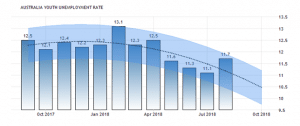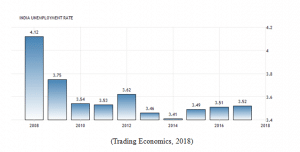Analyze Labour Market Outcomes for Younger People in Australia 2020
The main aim of this essay is to analyze Labour Market Outcomes for Younger People in Australia. As concerning of this, this essay determines the causes of the unemployment.
In the next section, this essay analyses the Supply and Demand curves in the article of the Labour Market Outcomes for Younger People.
At the same time, this essay also describes and evaluates the factors those motivates the 15-24-year-old work part-time or casual rather than full time.
In the next section, this essay describe the rate of youth unemployment and underemployment in Australia.
Furthermore, this essay compares and contrast rates of youth unemployment in Australia and India.
– Structural: The causes of structural unemployment are technological advancements and skill gaps among the workers. For instance, robots and advanced technologies have been replacing the unskilled workers.
At the same time, lack of required skills and competencies is one of the causes of the structural unemployment.
It is because there is the mismatch of the required skills by the employers and existing knowledge of the workers that reduced their ability to get the job (Brückner and Pappa, 2012).
– Cyclical: One of the reasons for cyclical unemployment is the economic slowdown. For example, employers are not uninterested in recruiting or retaining the workers during economic slowdown because they have less experience and lower skills.
The economic uncertainties may cause job losses during downturns and contractions in the business cycle. It has a negative growth for the country that also reflects in the conditions generated for unemployment.
At the same time, lack of demand is also a significant cause of cyclical unemployment; if there is a decline in consumer demand, then the business revenues affect that leads to declining productivity and employment (Gregory and Smith, 2016).
Due to a decline in demand and productivity, firms need to lay off workers to reduce costs and maintain profitability.
– Frictional: Frictional unemployment occurs when the employees search for the new jobs and transition from their old jobs to new ones.
It is known as voluntary unemployment due to the tendency of some workers to remain unemployed instead of taking the first job they are offered.
Some people are the more likely to search for new jobs because the jobs are not related to the field they studied as they reject the jobs.
– Hidden: The unemployment of potential workers that is not recorded in official records of the government.
The data on unemployment is not taken into consideration in official unemployment due to lack of proper data collection. Sometimes, people work as part-time but do not mention them as employment that is not collected in official records of the government (Fowkes, 2011).
At the same time, if the workers have stopped for looking jobs but still unemployed are no longer considered unemployed (Dhillon and Cassidy, 2018).
– Underemployment: Underemployment is related to the situation in which the workers get the jobs below their education or skill level or their availability.
For instance, it includes skilled workers in low paying jobs, skilled workers in low skill jobs and part-time workers who have to work as full-time workers. Unemployed workers who are currently searching for the job can be considered to be underemployed.
This may be due to adverse economic conditions like the recession in which workers have to work for low skilled jobs or at the low salary (Venn, 2012).
At the same time, this type of unemployment is possible when the supply for workers is higher than the demand of workers leading to layoffs or when the technology changes.
Over recent decades, the increase in the number of 20– 24 year olds working part-time who are not studying full time caused an increase in underemployment (Dhillon and Cassidy, 2018).
2. Factors causing changes in the Supply of 15 to 24-year old workers over time
Changes to the supply of younger workers to the labor force are related to the increasing number of workers and participation rate of the labor force. One of the factors that have caused changes in the supply of 15 to 24-year old workers over time is the increased educational attainment (Dhillon and Cassidy, 2018).
From the analysis, it is revealed that there was an increase in educational attainment like the increase in enrollment of 15– 19-year-olds in full-time education from 50% to 75% and increase in enrollment of 20– 24-year-olds in full-time education from 10% to 25% in the late 1980s.
It shows that the share of younger generation in enrolling the university has increased in educational attainment since the early 1980s, but the enrollment in technical education has declined.
Overall, it has been noticed that the enrollment of younger generation at the university has increased. It means the higher education has raised the opportunities for the individuals to get the employment in the labor market due to their compatibility with the technological change.
There is high demand for the workers with skills that are complementary to changes in technologies.
At the same time, the government spending and policy reforms on the education in Australia is also a significant factor in causing changes in the Supply of 15 to 24-year old workers over time (Crowley et al., 2013).
For instance, financial assistance schemes have been executed for the students are also the significant factor causing an increase in the Supply of 15 to 24-year old workers over time.
The government has supported the higher education sector by introducing these schemes including year 10 completion and full-time participation in education, training and/or employment until age 17 for all young people.
It is because this initiative helped to increase the demand of the skilled workforce due to the increasing supply of skilled workforce. On the other hand, economic conditions also have a significant impact on the employment rate for younger people in Australia (Dhillon and Cassidy, 2018).
In the economic slowdown, there is the low demand for products and services as the firms start to lay off the employees. In the historical time like in the 1980s, it was 7%, the unemployment rate of younger people in Australia was higher than the rest of the population (Abdelkerim, and Grace, 2012).
The improvement in economic conditions helped to increase the employment rate for the younger population due to more job opportunities like in 2017; it was 12.5%. But at the same time, since the 1980s, the gradual aging of the population and decline in the participation rate of younger workers due to full timing study also caused a decline in the Supply of 15 to 24-year old workers over time.
3. Factors that are driving the fact that 15-24-year-old work part-time or casual rather than full time
In Australian such countries, it can be seen that persons between age 15-24 years join the part time or casual jobs. In this age group, the most of the person are students.
These students join that part time job with the different aim and objectives. In the some cases, the part time job is that part of their study in which they have to take the training in the organization. complete the degree – It is one of the main motivational factors that create the interest of the people age group between 15-24 to do part time and causal job.
It allows the students and people complete the industrial training that is part of the cause work. It also helps the students to enhance the knowledge on the business environment (Hajkowicz et al., 2016).
To earn the money is also main factor that motivates the age group to join the part time job. People are required to some money for their person expenses and have few hours in daily life join the cause job.
In this, they search a job that can offer him a good hourly rate. In this, youths also have the some desire to save some money for the future needs and complete the degree of the high colleges.
In the same concern of this, it is also analysed that people age group of 15-24 years have desire to increase the knowledge on the industry and market. With this aim, they search and join causal job that improve their knowledge on the market and business process (Beer et al., 2016).
4. Rate of youth unemployment and underemployment in Australia
The youth unemployment rate refers to the number of unemployed 15-24 years olds expressed as a youth labor force percentage.
In Australia, the unemployment rate for younger people was around 12 1\2 percent in 2017, and now it is little higher than the average Organization for Economic Co-operation and Development (OECD) economics.
The rate of youth underemployment (15-19 years old) in Australia is 18 percent and a little higher than Organization for Economic Co-operation and Development (OECD).
There are reasons for this rate following –
- Financial crisis
The youth unemployment crisis was not only caused by the financial crises but also recession made existing problems such as in labor market, education system and others. The recession affects the quality and security of jobs which available to the young people (Cai, 2015).
- Mismatch of skills
There is a mismatch of the skills in youth as businesses needs skilled people where youth are not qualified with those skills that is needed by an organization. Similarly, young people who have advanced degree find overqualified for jobs.
- Lack of entrepreneurship skills
There is lack of entrepreneurship skills and life skills education as there are poor connection between the private sector and schools to promote training and experience and also having lack of instruction that can harness life skills that most students have.
- Lack of required capital
Young people who want to start their own business or want to establish a business struggle to find access loans. High interests on the loan also make the young people delay in repay of the loan on time.
- A digital divine
Technology is one of the reasons for the unemployment rate by having lack of access of internet or technology. There are many schools who are out of reach of internet and unable to afford the tool in digital sector to educate young people (McDonald, 2015).
5. Rates of youth unemployment in Australia and India and the world average

(Trading Economics, 2018)
Almost one-third of Australian young people are unemployed or underemployed, the highest level in 40 years, accounting to a report of Australia.
In February there were more than 650,000 people aged between 15 and 24 looking for work or underemployed. It point toward a rapids growth in insecure and non-permanent jobs, with youth people like to be work part-time jobs.
One of the causes of unemployment among the youth today is poverty. Some areas of the Australia have issue with poverty. In this areas finding jobs is often more difficult for youth people.
Youth people might not have the skill necessary to get a job. They were raise in a household that did not emphasize unemployment or they have attended school that do not have the proper knowledge (Quirk, 2015).
(Trading Economics, 2018)

Indian economy is under developing and role of economic growth is very slow. This slow growth fails to provide enough unemployment opportunities t the increasing population.
Indian population is increasing rapidly. The growth of population directly encouraged the unemployment by making large addition to labour force.
Indian farmer cannot feed properly many people by the produce of his farm and he is unable to provide his children with proper education to engage them in any profession it leads to unemployment problems (Hsieh, 2016).
On the basis of the above analysis, it can be concluded that the main cause of the unemployment are technology advances, lack of skilled person and not relevant job in the market.
The persons of age group 15-24 are more active in the work that is why these demand is increasing.
There are some factors that also motivates to these age group people to do part time job such as completion of the industry training, earn money and enhance knowledge of market and business.
Abdelkerim, A.A. and Grace, M., 2012. Challenges to employment in newly emerging African communities in Australia: A review of the literature. Australian Social Work, 65(1), pp.104-119.
Beer, A., Bentley, R., Baker, E., Mason, K., Mallett, S., Kavanagh, A. and LaMontagne, T., 2016. Neoliberalism, economic restructuring and policy change: Precarious housing and precarious employment in Australia. Urban studies, 53(8), pp.1542-1558.
Brückner, M. and Pappa, E., 2012. Fiscal expansions, unemployment, and labor force participation: Theory and evidence. International Economic Review, 53(4), pp.1205-1228.
Cai, L., 2015. The dynamics of low pay employment in Australia. International Journal of Manpower, 36(7), pp.1095-1123.
Crowley, L., Jones, K., Cominetti, N. and Gulliford, J., 2013. International Lessons: Youth unemployment in the global context. Lancaster University.
Dhillon, Z. and Cassidy, N. 2018. RESERVE BANK OF AUSTRALIA. BULLE TIN – JUNE 2018. [online] Avaibale at: https://www.rba.gov.au/publications/bulletin/2018/jun/pdf/labour-market-outcomes-for-younger-people.pdf [Accessed: 13 September 2018]
Fowkes, L., 2011. Long-term unemployment in Australia.
Gregory, R.G. and Smith, R.E., 2016. 15 Unemployment, Inflation and Job Creation Policies in Australia. Inflation and Unemployment: Theory, Experience and Policy Making, p.325.
Hajkowicz, S.A., Reeson, A., Rudd, L., Bratanova, A., Hodgers, L., Mason, C. and Boughen, N., 2016. Tomorrow’s digitally enabled workforce: Megatrends and scenarios for jobs and employment in Australia over the coming twenty years. Australian Policy Online.
Hsieh, Y.J.T., 2016. Male Muslim Refugee Experiences of English Language Training Programmes and Links to Employment in Australia.
McDonald, P., 2015. International migration and employment in Australia. Population Review, 54(2).
Quirk, V., 2015. Restore full employment in Australia to shift the balance of power back towards working people. Australian Socialist, 21(1), p.3.
Trading Economics., 2018. [Online] Available at: https://tradingeconomics.com/ (Assessed: 9th September 2018)
Venn, D., 2012. Eligibility criteria for unemployment benefits.


